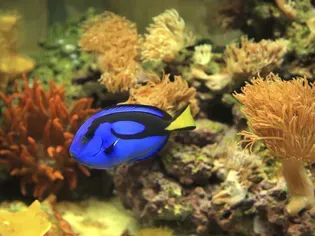Controlling Algae in Your Saltwater Aquarium
Updated on 04/26/24

Conquering the Green Menace: A Comprehensive Guide to Algae Control in Your Saltwater Aquarium
Introduction: Algae - A Double-Edged Sword
Algae, the ubiquitous green growth in saltwater aquariums, can be both a blessing and a curse. While certain algae species provide essential nutrients and shelter for marine life, excessive algae growth can turn your aquarium into an unsightly, unhealthy environment. Understanding algae growth and implementing effective control measures are crucial for maintaining a flourishing and aesthetically pleasing saltwater aquarium.
Types of Algae and Their Impacts
Various algae species thrive in saltwater aquariums, each with distinct characteristics and impacts:
* Green hair algae: Long, filamentous algae that cling to surfaces, obstructing water flow and reducing light penetration.
* Brown diatoms: Single-celled algae that form a brown, powdery layer on surfaces, particularly prevalent during tank cycling.
* Red slime algae (Cyanobacteria): Filamentous algae that form a slimy, reddish mat on surfaces, releasing harmful toxins.
* Coralline algae: Encrusting algae that forms a purple or pink crust, providing a valuable calcium source for marine organisms.
Causes of Algae Overgrowth
Understanding the root causes of algae overgrowth is essential for effective control:
* Excessive nutrients: Nitrates and phosphates from fish waste, uneaten food, and decaying organic matter fuel algae growth.
* Insufficient water flow: Stagnant water creates ideal conditions for algae to thrive.
* Inadequate filtration: Inefficient filtration systems may fail to remove nutrients and debris that contribute to algae buildup.
* Overfeeding: Excess food provides ample nutrients for algae to flourish.
* Insufficient lighting: Low light levels can limit the growth of beneficial algae that compete with nuisance algae.
Prevention and Control Measures
Controlling algae overgrowth requires a multi-faceted approach:
1. Nutrient Reduction:
* Perform regular water changes of 10-20% weekly to remove excess nutrients.
* Use a nitrate-removing filter media or employ a nitrate-reducing bacteria additive.
* Vacuum the substrate regularly to remove uneaten food and decaying organic matter.
* Limit fish feeding to only what they can consume in a few minutes.
2. Improving Water Flow:
* Install a powerhead or additional pumps to create a gentle current throughout the aquarium.
* Use wavemakers to simulate natural wave action and increase water circulation.
3. Enhancing Filtration:
* Upgrade to a more powerful filter if necessary to ensure efficient filtration.
* Consider using a canister filter or a hang-on-back filter with multiple stages of filtration media.
* Change filter media as recommended by the manufacturer to maintain filtration efficiency.
4. Algae Removal Techniques:
* Manual removal: Use a soft-bristled brush to physically remove algae from surfaces. Avoid using sharp objects that could damage the aquarium glass.
* Chemical algae treatment: Introduce algae-killing chemicals such as erythromycin or hydrogen peroxide to the water. Follow manufacturer's instructions carefully to avoid harming marine life.
* Biological control: Introduce algae-eating organisms such as snails, crabs, hermits, or certain fish species to consume algae.
5. Lighting Optimization:
* Provide adequate lighting to support the growth of beneficial algae, which compete with nuisance algae.
* Ensure that lighting is balanced between intensity and duration to avoid excessive algae growth.
* Consider using a timer to control lighting hours.
6. Other Measures:
* Quarantine new fish and corals to prevent the introduction of algae spores.
* Avoid using tap water for water changes, as it may contain algae-promoting nutrients.
* Perform regular aquarium maintenance, including glass cleaning and equipment inspection, to prevent algae accumulation.
Conclusion: Maintaining a Balanced Ecosystem
Controlling algae in a saltwater aquarium is an ongoing process that requires patience and consistency. By implementing these prevention and control measures, you can effectively manage algae growth, maintain a healthy ecosystem, and enjoy a beautiful and thriving marine environment. Remember, achieving a balanced aquarium ecosystem is a journey, not a destination, and requires ongoing monitoring and adjustments to ensure the well-being of your aquatic inhabitants.
Explore More Pets

Freshwater Aquarium Filters
How to Deal With Cloudy Aquarium Water

Saltwater Aquarium Filters
How Do You Remove Chloramines From Tap Water?

Freshwater Aquariums & Habitat
Can I Keep My Koi Fish Inside?

Saltwater Aquariums & Habitat
14 Best Floating Plants for Your Aquarium

Freshwater Fish Health
How to Treat Ich on Freshwater Fish

Saltwater Fish Health
Fin Rot in Aquarium Fish

Freshwater Aquarium Filters
How to Do Aquarium Water Changes

Saltwater Fish Health
How Do Fish Get Parasites?